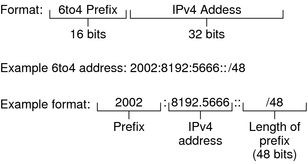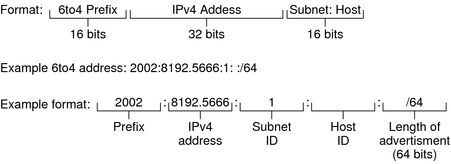| Skip Navigation Links | |
| Exit Print View | |

|
System Administration Guide: IP Services Oracle Solaris 11 Express 11/10 |
| Skip Navigation Links | |
| Exit Print View | |

|
System Administration Guide: IP Services Oracle Solaris 11 Express 11/10 |
1. Planning an IPv4 Addressing Scheme (Tasks)
2. Planning an IPv6 Addressing Scheme (Overview)
3. Planning an IPv6 Network (Tasks)
4. Configuring TCP/IP Network Services and IPv4 Addressing (Tasks)
5. Enabling IPv6 on a Network (Tasks)
6. Administering a TCP/IP Network (Tasks)
8. Troubleshooting Network Problems (Tasks)
9. TCP/IP and IPv4 in Depth (Reference)
Oracle Solaris IPv6 Implementation
/etc/inet/ipaddrsel.conf Configuration File
netstat Command Modifications for IPv6 Support
snoop Command Modifications for IPv6 Support
route Command Modifications for IPv6 Support
ping Command Modifications for IPv6 Support
traceroute Command Modifications for IPv6 Support
in.ndpd Daemon, for Neighbor Discovery
in.ripngd Daemon, for IPv6 Routing
inetd Daemon and IPv6 Services
IPv6 Neighbor Discovery Protocol
ICMP Messages From Neighbor Discovery
Obtaining a Router Advertisement
Prefix Configuration Variables
Neighbor Solicitation and Unreachability
Duplicate Address Detection Algorithm
Comparison of Neighbor Discovery to ARP and Related IPv4 Protocols
IPv6 Extensions to Oracle Solaris Name Services
Changes to the nsswitch.conf File
Changes to Name Service Commands
12. Planning for DHCP Service (Tasks)
13. Configuring the DHCP Service (Tasks)
14. Administering DHCP (Tasks)
15. Configuring and Administering the DHCP Client
16. Troubleshooting DHCP (Reference)
17. DHCP Commands and Files (Reference)
18. IP Security Architecture (Overview)
20. IP Security Architecture (Reference)
21. Internet Key Exchange (Overview)
23. Internet Key Exchange (Reference)
24. IP Filter in Oracle Solaris (Overview)
Part IV Networking Performance
26. Integrated Load Balancer Overview
27. Configuration of Integrated Load Balancer Tasks
28. Virtual Router Redundancy Protocol (Overview)
29. VRRP Configuration (Tasks)
30. Implementing Congestion Control
Part V IP Quality of Service (IPQoS)
31. Introducing IPQoS (Overview)
32. Planning for an IPQoS-Enabled Network (Tasks)
33. Creating the IPQoS Configuration File (Tasks)
34. Starting and Maintaining IPQoS (Tasks)
35. Using Flow Accounting and Statistics Gathering (Tasks)
Chapter 2, Planning an IPv6 Addressing Scheme (Overview) introduces the most common IPv6 addressing formats: unicast site address and link-local address. This section includes in-depth explanations of addressing formats that are not covered in detail in Chapter 2, Planning an IPv6 Addressing Scheme (Overview):
If you plan to configure a 6to4 tunnel from a router or host endpoint, you must advertise the 6to4 site prefix in the /etc/inet/ndpd.conf file on the endpoint system. For an introduction and tasks for configuring 6to4 tunnels, refer to Chapter 7, Configuring IP Tunnels.
The next figure shows the parts of a 6to4 site prefix.
Figure 10-1 Parts of a 6to4 Site Prefix

The next figure shows the parts of a subnet prefix for a 6to4 site, such as you would include in the ndpd.conf file.
Figure 10-2 Parts of a 6to4 Subnet Prefix

This table explains the parts of a 6to4 subnet prefix, their respective lengths, and their definitions.
|
When an IPv6 host receives the 6to4-derived prefix by way of a router advertisement, the host automatically reconfigures a 6to4-derived address on an interface. The address has the following format:
prefix:IPv4-address:subnet-ID:interface-ID/64
The output from the ipadm -a command on a host with a 6to4 interface might resemble the following:
ADDROBJ TYPE STATE ADDR bge0/? addrconf ok 2002:8192:56bb:9258:a00:20ff:fea9:4521/64
This table explains the parts of the 6to4-derived address, their lengths and the information they provide.
|
The IPv6 multicast address provides a method for distributing identical information or services to a defined group of interfaces, called the multicast group. Typically, the interfaces of the multicast group are on different nodes. An interface can belong to any number of multicast groups. Packets sent to the multicast address go to all members of the multicast group. For example, one use of multicast addresses is for broadcasting information, similar to the capability of the IPv4 broadcast address.
The following table shows the format of the multicast address.
Table 10-1 IPv6 Multicast Address Format
|
The following is a summary of the contents of each field.
11111111 – Identifies the address as a multicast address.
FLGS – Set of the four flags 0,0,P,T. The first two flags must be zero. The P field has one of the following values:
0 = Multicast address that is not assigned based on the network prefix
1 = Multicast address that is assigned based on the network prefix
If P is set to 1, then T must also be 1.
Reserved - Reserved value of zero.
Plen - Number of bits in the site prefix that identify the subnet, for a multicast address that is assigned based on a site prefix.
Group ID - Identifier for the multicast group, either permanent or dynamic.
For complete details about the multicast format, refer to RFC 3306, "Unicast-Prefix-based IPv6 Multicast Addresses.
Some IPv6 multicast addresses are permanently assigned by the Internet Assigned Numbers Authority (IANA). Some examples are the All Nodes Multicast Addresses and All Routers Multicast Addresses that are required by all IPv6 hosts and IPv6 routers. IPv6 multicast addresses can also be dynamically allocated. For more information about the proper use of multicast addresses and groups, see RFC 3307, "Allocation Guidelines for IPv6 Multicast Addresses".